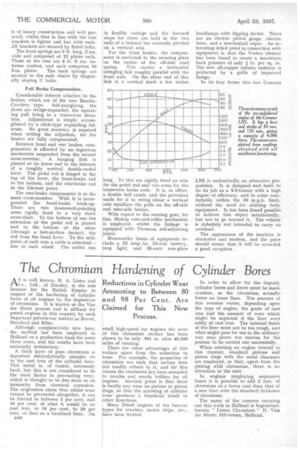The Chr
Page 44

If you've noticed an error in this article please click here to report it so we can fix it.
mium Hardening of
Cylinder Bores
Reductions in Cylinder Wear ounting to Between 80 nd 98 Per Cent. Are laimed for This New Process.
As is well known, R. A. ister and Co., Ltd., of Dursley, is the sole licensee for the British 4mpire in respect of the hardening of cylinder bores of oil engines by the deposition of chromium. It is known as the Van der Horst process and is utilized for petrol engines in this country by such important private-car makers as Rover, Standard and Riley.
Although comparatively ew here, the method has been employed in Holland on a production basi for some three years, and the results ave been eminently satisfactory.
A thick layer of pure ch ornium is deposited electrolytically $ aight on to the cast iron of the cyli der bore. This metal is, of course, extremely hard, but this is not consid red to be the main factor in preventing wear, which is thought to be due rIore to its immunity from chemical corrosion. The originators claim that wlhilst wear cannot be prevented altoget er, it can be limited to between 2 per cent. and 10 per cent, of what it wo kl be on cast iron, or 10 per cent. o 20 per cent. of that on a hardened iner. On
B10 small high-speed car engines the wear of this chromium surface has been shown to be only .001 in. after 40,000 miles of running.
There are other advantages of this surface apart from the reduction in wear. For example, the properties of chromium are such that carbon does not readily adhere to it, and for this reason the treatment has been extended o nozzles and nozzle holders for oil ngines. Another point is that there 's hardly any wear on pistons or piston 'rigs, so that the arresting of cylinder ear produces a beneficial result in other directions.
Many Diesel engines of the heavier types for trawlers, motor ships, etc., have been treated. In order to allow for the deposit, cylinder bores and liners must be made oversize, as the chromium actually forms an inner liner. The amount of this oversize varies, depending upon the type of engine, the grade of cast iron and the amount of wear which might be expected if the liner were solely of cast iron. The internal finish of the liner must not be too rough, and what might pass for use in the ordinary way may prove too uneven for the process to be carried out successfully.
When erecting an engine treated in this manner, standard pistons and piston rings with the usual clearance are employed, so that, apart from the plating with chromium, there is no alteration in the unit.
In engines employing expensive liners it is possible to add 2 mm. of chromium at a lower cost than that of a new liner with the standard thickness of chromium.
The name of the concern carrying out this work in Holland is Ingenieurs
• bureau " Lemet Chromium" H. -Van der Horst, Hilversum, Holland.




























































































